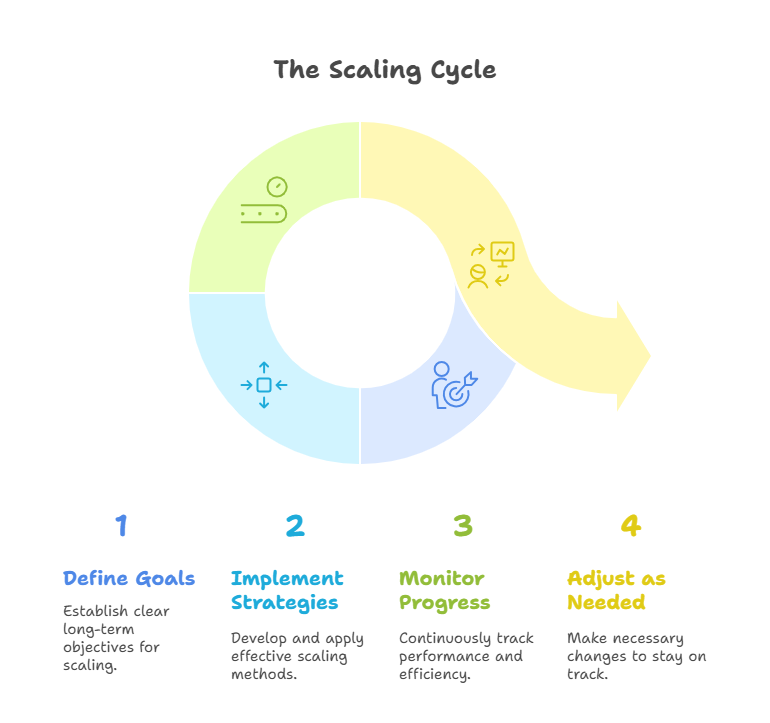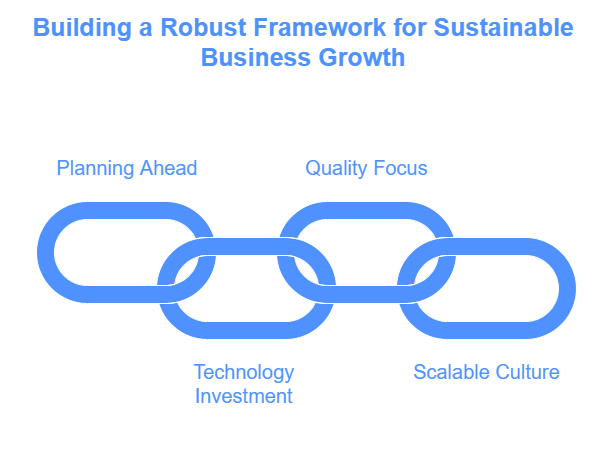Scaling is a fundamental concept that plays a critical role in various domains, including business, technology, science, and even personal growth. At its core, scaling refers to the ability to grow or expand a system, process, or organization while maintaining or improving its efficiency, performance, and quality. However, scaling is not just about getting bigger—it’s about getting better. It’s about ensuring that growth is sustainable, manageable, and aligned with long-term goals.
In this article, we’ll take a deep dive into the concept of scaling, explore its types in detail, and discuss the challenges and strategies involved in scaling effectively.
Understanding Scaling: A Comprehensive Perspective
Scaling is often associated with growth, but it’s important to distinguish between growth and scaling. Growth typically refers to an increase in size, revenue, or output, while scaling refers to the ability to handle that growth efficiently. For example, a business might grow by increasing its customer base, but scaling ensures that the business can serve those customers without compromising on quality or overextending its resources.
Scaling is not a one-size-fits-all process. It requires careful planning, resource allocation, and adaptability. Whether you’re scaling a business, a software system, or a project, the principles remain the same: you need to ensure that the system can handle increased demand, maintain performance, and deliver consistent results.
Types of Scaling: A Detailed Exploration
Scaling can be categorized into several types, each with its own unique characteristics, advantages, and challenges. Let’s explore these types in depth:
1. Vertical Scaling (Scaling Up)
- Definition: Vertical scaling involves increasing the capacity of an existing system by adding more resources to it. This could mean upgrading hardware, increasing storage, or enhancing processing power.
- Example: In the context of a server, vertical scaling might involve adding more RAM, a faster CPU, or a larger hard drive to handle increased traffic or data processing needs.
- Advantages:
- Simplicity: Vertical scaling is often easier to implement because it involves upgrading a single system rather than managing multiple systems.
- Cost-Effective (Initially): For small to medium-sized growth, vertical scaling can be more cost-effective than horizontal scaling.
- Disadvantages:
- Limited Scalability: There’s a physical limit to how much you can scale up. Once you reach the maximum capacity of a system, further upgrades may not be possible.
- Single Point of Failure: Relying on a single system can be risky. If that system fails, the entire operation could be disrupted.
- Use Cases: Vertical scaling is often used in scenarios where the growth is predictable and the system can handle the increased load with minor upgrades.
2. Horizontal Scaling (Scaling Out)
- Definition: Horizontal scaling involves adding more systems or nodes to distribute the workload. Instead of making a single system more powerful, you add more systems to share the load.
- Example: In cloud computing, horizontal scaling might involve adding more servers to a cluster to handle increased traffic or data processing demands.
- Advantages:
- High Scalability: Horizontal scaling offers virtually unlimited scalability because you can keep adding more systems as needed.
- Fault Tolerance: Distributing the workload across multiple systems reduces the risk of a single point of failure.
- Disadvantages:
- Complexity: Managing multiple systems can be more complex and require additional tools and expertise.
- Higher Initial Costs: Setting up multiple systems can be more expensive initially, especially if you need to invest in networking and load-balancing infrastructure.
- Use Cases: Horizontal scaling is ideal for systems that need to handle unpredictable or rapidly growing demand, such as web applications or e-commerce platforms.

3. Diagonal Scaling (Hybrid Scaling)
- Definition: Diagonal scaling combines vertical and horizontal scaling to create a more flexible and efficient scaling strategy. It involves upgrading existing systems while also adding new ones.
- Example: A company might upgrade its existing servers (vertical scaling) while also adding new servers to the network (horizontal scaling) to handle a sudden surge in demand.
- Advantages:
- Flexibility: Diagonal scaling allows you to leverage the benefits of both vertical and horizontal scaling.
- Optimized Resource Utilization: By combining both approaches, you can optimize resource allocation and reduce costs.
- Disadvantages:
- Complexity: Managing a hybrid scaling strategy can be more complex and require advanced planning.
- Higher Costs: Diagonal scaling can be more expensive due to the need for both upgrades and additional systems.
- Use Cases: Diagonal scaling is often used in scenarios where the demand is highly variable or where both performance and scalability are critical.
4. Functional Scaling
- Definition: Functional scaling focuses on optimizing specific functions or processes within a system to improve efficiency and performance. It’s about making individual components work better rather than simply adding more resources.
- Example: A business might streamline its supply chain process to reduce costs and improve delivery times, allowing it to handle more orders without increasing resources.
- Advantages:
- Improved Efficiency: Functional scaling can lead to significant improvements in efficiency and productivity.
- Cost Savings: By optimizing processes, you can reduce waste and lower operational costs.
- Disadvantages:
- Requires Expertise: Functional scaling often requires a deep understanding of the system and may involve significant changes.
- Limited Scope: Functional scaling focuses on specific areas, so it may not address broader scalability issues.
- Use Cases: Functional scaling is ideal for organizations looking to improve specific processes or functions, such as customer service, manufacturing, or logistics.
5. Geographical Scaling
- Definition: Geographical scaling involves expanding operations or services to new locations or regions. It’s about growing your reach beyond your current area.
- Example: A retail chain opening new stores in different cities or countries is an example of geographical scaling.
- Advantages:
- Market Expansion: Geographical scaling allows you to tap into new markets and diversify revenue streams.
- Risk Diversification: Operating in multiple regions can reduce the risk of being overly dependent on a single market.
- Disadvantages:
- Cultural and Regulatory Challenges: Expanding to new regions often requires navigating different cultural, legal, and regulatory environments.
- Operational Complexity: Managing operations across multiple locations can be challenging and require additional resources.
- Use Cases: Geographical scaling is ideal for businesses looking to expand their market presence and reduce reliance on a single region.
Challenges of Scaling
While scaling offers numerous benefits, it also comes with its own set of challenges.
- Resource Allocation: Scaling often requires significant investment in resources, whether it’s hardware, software, or human capital.
- Complexity: As systems grow, they become more complex and harder to manage. This can lead to increased operational overhead and the need for specialized expertise.
- Quality Control: Ensuring that the quality of products or services remains consistent as you scale can be difficult, especially when dealing with rapid growth.
- Cultural and Market Differences: Geographical scaling requires understanding and adapting to different cultural, legal, and market conditions, which can be challenging.
Strategies for Effective Scaling
To overcome these challenges and scale successfully, consider the following strategies:
- Plan Ahead: Scaling requires careful planning and foresight. Anticipate future growth and plan your scaling strategy accordingly.
- Invest in Technology: Leverage technology to automate processes, improve efficiency, and reduce operational overhead.
- Focus on Quality: Maintain a strong focus on quality control to ensure that your products or services remain consistent as you scale.
- Build a Scalable Culture: Foster a culture of adaptability and continuous improvement within your organization to support scaling efforts.
Conclusion
Scaling is a critical process that enables growth while maintaining efficiency, performance, and quality. By understanding the different types of scaling and the challenges involved, you can develop a scaling strategy that aligns with your goals and ensures long-term success. Whether you’re scaling a business, a software system, or a project, the key is to grow smartly and sustainably.

FAQs About Scaling
Scaling is a critical concept in various fields, including business, technology, and science. It refers to the process of growing or expanding a system, process, or organization while maintaining or improving its efficiency, performance, and quality. Here are some frequently asked questions (FAQs) to help you understand scaling in depth:
1. What is Scaling?
Scaling refers to the ability to grow or expand a system, process, or organization in a way that maintains or enhances its efficiency, performance, and quality. It’s about handling increased demand or size without compromising on core functionality.
2. Why is Scaling Important?
Scaling is important because:
- It ensures that growth is sustainable and manageable.
- It helps maintain or improve performance and quality as demand increases.
- It allows organizations to handle higher workloads, more customers, or larger datasets without breaking down.
- It supports long-term success and competitiveness.
3. What are the Types of Scaling?
There are several types of scaling, including:
- Vertical Scaling (Scaling Up): Adding more resources (e.g., RAM, CPU) to an existing system.
- Horizontal Scaling (Scaling Out): Adding more systems or nodes to distribute the workload.
- Diagonal Scaling: A combination of vertical and horizontal scaling.
- Functional Scaling: Optimizing specific processes or functions to improve efficiency.
- Geographical Scaling: Expanding operations or services to new locations or regions.
4. What is Vertical Scaling?
- Definition: Vertical scaling involves increasing the capacity of an existing system by adding more resources, such as memory, storage, or processing power.
- Example: Upgrading a server’s RAM to handle more traffic.
- Pros: Simple to implement, cost-effective for small to medium growth.
5. What is Horizontal Scaling?
- Definition: Horizontal scaling involves adding more systems or nodes to distribute the workload.
- Example: Adding more servers to a network to handle increased traffic.
- Pros: High scalability, fault tolerance.
- Cons: More complex to manage, higher initial costs.
6. What is Diagonal Scaling?
- Definition: Diagonal scaling combines vertical and horizontal scaling to create a flexible and efficient scaling strategy.
- Example: Upgrading existing servers while also adding new ones to handle a surge in demand.
- Pros: Combines the benefits of both vertical and horizontal scaling.
- Cons: More complex and expensive to implement.
7. What is Functional Scaling?
- Definition: Functional scaling focuses on optimizing specific functions or processes within a system to improve efficiency and performance.
- Example: Streamlining a supply chain process to reduce costs and improve delivery times.
- Pros: Improves efficiency, reduces costs.
- Cons: Requires expertise, limited to specific areas.
8. What is Geographical Scaling?
- Definition: Geographical scaling involves expanding operations or services to new locations or regions.
- Example: A retail chain opening new stores in different cities or countries.
- Pros: Expands market reach, diversifies revenue streams.
- Cons: Cultural and regulatory challenges, operational complexity.
9. What are the Challenges of Scaling?
Scaling comes with several challenges, including:
- Complexity: As systems grow, they become harder to manage.
- Quality Control: Maintaining quality as you scale can be difficult.
- Cultural and Market Differences: Geographical scaling requires adapting to new environments.
10. What are the Benefits of Scaling?
The benefits of scaling include:
- Improved Efficiency: Scaling helps optimize processes and resource utilization.
- Increased Capacity: It allows systems to handle higher workloads or demand.
- Enhanced Performance: Scaling ensures that performance remains consistent as systems grow.
- Long-Term Growth: It supports sustainable and manageable growth.
11. How Do You Scale a Business?
Scaling a business involves:
- Planning: Anticipate growth and plan your scaling strategy.
- Investing in Technology: Use technology to automate processes and improve efficiency.
- Building a Scalable Culture: Foster adaptability and continuous improvement.
- Focusing on Quality: Ensure that quality remains consistent as you scale.
12. How Do You Scale a Software System?
Scaling a software system involves:
- Vertical Scaling: Upgrading hardware or software to handle more load.
- Horizontal Scaling: Adding more servers or nodes to distribute the workload.
- Optimizing Code: Improving code efficiency to reduce resource usage.
- Using Cloud Services: Leveraging cloud platforms for flexible and scalable infrastructure.
13. What is the Difference Between Scaling Up and Scaling Out?
- Scaling Up (Vertical Scaling): Adding more resources to an existing system.
- Scaling Out (Horizontal Scaling): Adding more systems or nodes to distribute the workload.
14. What is Auto-Scaling?
Auto-scaling is a feature offered by cloud platforms that automatically adjusts the number of resources (e.g., servers) based on demand. It ensures that systems can handle traffic spikes without manual intervention.
15. What are Some Examples of Scaling in Real Life?
- Business: A small bakery expanding to multiple locations.
- Technology: A website adding more servers to handle increased traffic.
- Science: A research project scaling up experiments to test larger datasets.
16. How Do You Measure Scaling Success?
Scaling success can be measured by:
- Performance Metrics: System response time, throughput, and resource utilization.
- Quality Metrics: Consistency in product or service quality.
- Financial Metrics: Revenue growth, cost efficiency, and return on investment (ROI).
17. What Tools or Technologies Support Scaling?
Some tools and technologies that support scaling include:
- Containerization: Tools like Docker and Kubernetes for managing scalable applications.
- Monitoring Tools: Track system performance and resource usage.
18. What are Common Mistakes in Scaling?
Common mistakes include:
- Underestimating Demand: Failing to plan for sufficient growth.
- Ignoring Quality: Sacrificing quality for rapid expansion.
- Overcomplicating Systems: Adding unnecessary complexity.
- Lack of Monitoring: Not tracking performance and resource usage.
19. How Can You Overcome Scaling Challenges?
To overcome scaling challenges:
- Plan Ahead: Anticipate growth and plan your scaling strategy.
- Invest in Training: Equip your team with the skills needed to manage scaling.
- Monitor Performance: Use tools to track system performance and identify bottlenecks.
- Stay Flexible: Be prepared to adapt your strategy as needed.
20. What is the Future of Scaling?
The future of scaling involves:
- AI and Automation: Using AI to optimize scaling processes.
- Edge Computing: Distributing resources closer to users for faster performance.
- Sustainable Scaling: Focusing on environmentally friendly and resource-efficient scaling practices.
